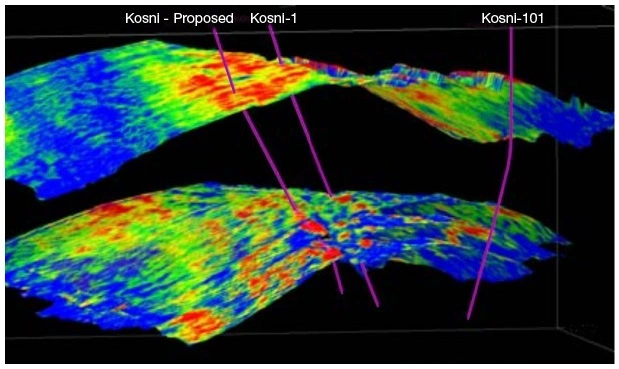Interpretation with Seismic Attributes

Learning Objectives
After completing this topic “Interpretation with Seismic Attributes”, you will be able to:
- Provide the definition of seismic attributes.
- Describe how and where seismic attributes are applied.
- Explain how seismic attributes are classified.
- Outline how AVO attributes are used to analyze changes in the amplitude of seismic waves.
- Discuss why the application of the coherence attribute is very useful to interpreters.
- List the well-known instantaneous attributes and define which geologic and geophysical features they can enhance.
Introduction To Interpretation with Seismic Attributes
As described by Taner (2001), “Seismic attributes are all the information obtained from seismic data, either by direct measurements or by logical or experience based reasoning.” Attributes extend the study of seismic data from stratigraphy and structural interpretation to the direct visualization of the rock properties, fluids, elasticity, fractures, etcetera.
Attributes provide detailed and accurate information to the interpreter on structural, stratigraphic and lithological parameters of the seismic prospect, by facilitating the recognition of hydrocarbon anomalies, and providing validation of anomalies that reveal the relationship between subsurface rocks and seismic data.
From the study of the seismic amplitudes, it is possible to derive some physical parameters of the rocks such as acoustic impedance, velocity, reflection coefficients, etcetera. Using the phase component, the geometric configuration of reflectors can be obtained.
Attributes are extracted from seismic data and applied using the following approach:
- Define a model that explains the existing anomalies.
- Compute the forward response to the model.
- Compare the response of the model to the actual data.
- Adjust the model as many times as necessary or possible to match the model to the seismic data.
- Verify new areas or intervals.
In terms of input data, seismic attributes can be classified into two categories pre-stack (before the stack) and post-stack (after data is stacked).
In terms of computational calculations, seismic attributes can be classified into the following categories:
- Instantaneous attributes: Some calculated examples are sample-by-sample, such as the trace envelope and its derivatives frequency and phase.
- Wavelet attributes: These are computed at the peak of the trace envelope with the Fourier Transform; instantaneous frequency (the rate of change of phase as a function of time) is an example of this type of attribute.
- Physical attributes: These relate to physical the qualities of rocks frequencies relate to the bed thickness, and the magnitude of the trace envelope relates to the impedance contrast.
- Geometric attributes: These describe the spatial and temporal relationship of all other attributes. For example, lateral continuity measured by semblance is a good indicator of a discontinuity.
We can further subdivide the attributes into two categories based on their origin in the wave phenomena:
- Reflective attributes:
- Attributes corresponding to the characteristics of interfaces
- All instantaneous and wavelet attributes
- Pre-stack attributes, such as amplitude versus offset (AVO)
- Transmissive attributes:
- Relate to the characteristics of a bed between two interfaces
- Interval, RMS and average velocities, Q, absorption and dispersion
The trace envelope (Animation 1) shows that the seismic data can be viewed analytically as a combination of real and imaginary parts. It is a physical attribute which can be used as an effective discriminator of the following characteristics:
- Reflectivity it mainly represents the acoustic impedance contrast
- Bright spots indicates possible gas accumulation
- Sequence boundaries
- Thin-bed tuning effects
- Major changes in the depositional environment
- Spatial correlation to porosity and other lithologic variations
- Indicates the group, rather than the phase component, of the seismic wave propagation
The first derivative of the trace envelope the time rate of change of the envelope shows the variation of the energy of the reflected events. This attribute is also a physical attribute that can be used to detect possible fracturing and absorption effects.
The second derivative of the trace envelope provides a measure of the sharpness of the envelope peak. It can be used to identify all reflecting interfaces within the seismic bandwidth.
Following is a list of additional attributes that play a significant role in rock and lithology interpretation:
- Instantaneous amplitude (also known as reflection strength): The square root of the total energy of the seismic signal at an instant of time; the amplitude independent of phase, and an effective tool to identify bright and dim spots because it provides information about contrasts in acoustic impedance
- Instantaneous phase: A physical attribute that can be effectively used for interpreting geometric shapes
- Instantaneous frequency: A physical attribute that is used as a hydrocarbon indicator through the identification of low frequency areas; also assists with locating fracture zones and bed thicknesses
- Statistics of attributes: This involves geostatistics, such as correlation and sequence
- Linear Discrimination Analysis (LDA) and Principal Component Analysis (PCA)
- Ratio and phase differences
- The Coherence cube
- Instantaneous dip azimuth
- Semblance lateral event continuity





